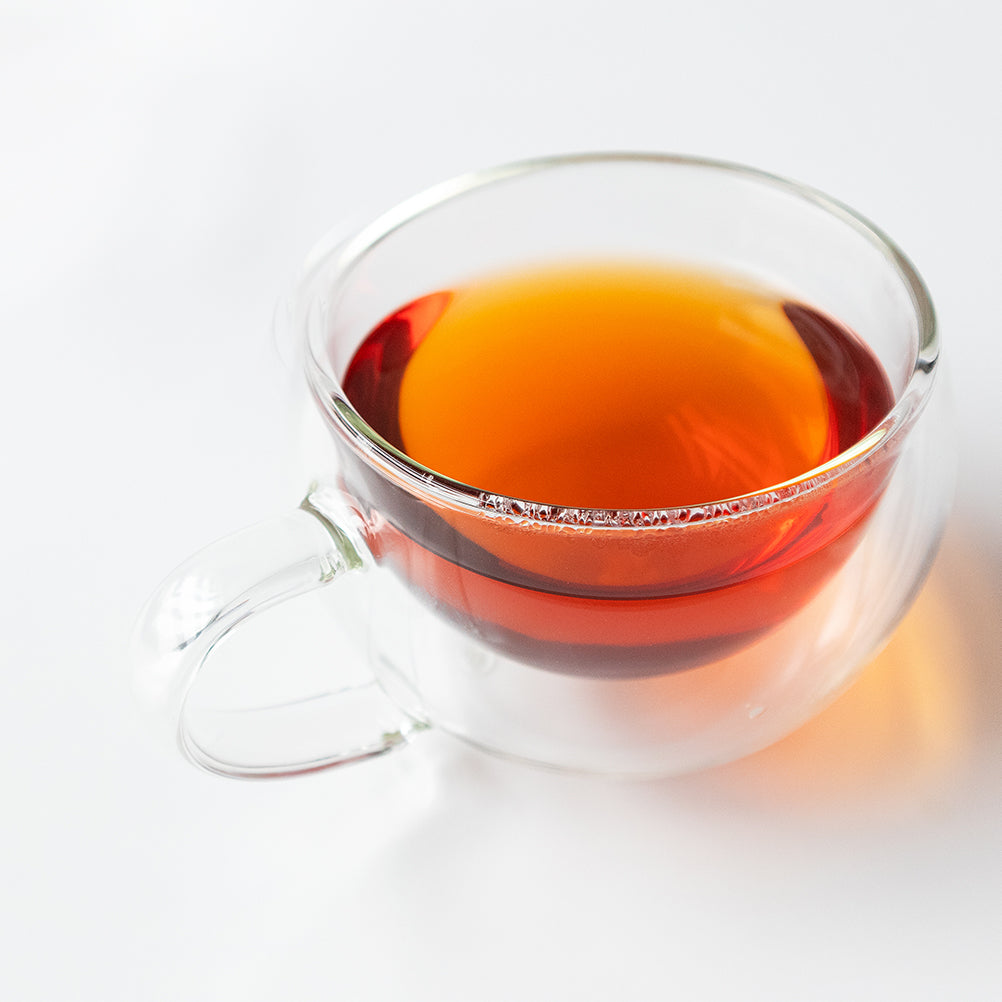All Teas Are Different, Right?

Every tea is different, right? White tea, green tea, oolong, black tea, and pu-erh all come from different plants, right? There’s no possible way they could all come from the same plant, right? Wrong. Camellia sinensis. Though it sounds like a mythical, all-knowing tree, it’s actually just a waist-high shrub, but it’s responsible for many of the teas you know and love. Did someone say Assam?
There are two varieties of the plant: camellia sinensis sinensis, first discovered in China; and camellia sinensis assamica, which is native to India. Camellia sinensis sinensis is a cold-tolerant plant that produces small leaves that are plucked and oxidized to varying degrees to create white tea, oolong, and green tea. Sinensis assamica leaves are much larger and prefer the company of warmer climates and plentiful rain. When oxidized, sinensis assamica leaves make some bold black teas.
But the camellia rollercoaster doesn’t stop there. Get ready for a few loop-de-loops.
On the surface, all tea leaves sound the same, but there’s one key difference: air. Specifically, oxidization, which is the process by which incremental amounts of oxygen are absorbed by the leaves, changing their flavor. Heat is then applied to the leaves to stop oxidization.

White teas, which are unoxidized, are typically low in caffeine content and feature delicate, floral notes. Teas like our White Peony and Pomegranate White are smooth and brew soft-colored as an early-morning sun. White teas are best steeped at between 160°F and 170°F for 3 minutes, which is considerably cooler and shorter than heartier teas like Assam TGFOP are steeped. Because the flavor of white tea is already very delicate, adding cream, milk, or sugar isn’t advisable, as they would likely just make your cup taste like milky, sugary water.
White tea is composed of fresh, young tea leaves and buds. This tea requires special harvesting within the early spring months when the weather is most favorable. White tea is considered the “champagne of teas.” These teas have lower caffeine levels and have a sweet, mild flavor.

Like white teas, green teas are also primarily unoxidized, but they are high in caffeine content. If you’re looking to wake up—and we mean wake up—leave the white tea for more hyggelig times. Because of green tea’s minimal processing, these teas are packed with more antioxidants, chlorophyll, and polyphenols than most other types of tea. Leaves are harvested, gently withered, and cooked or pan-fired to keep the tea from becoming overly oxidized. Green tea brews a golden color, with flavors ranging from savory and vegetal to clean and sweet.
Green teas brew best between 175°F and 185°F for 3 to 4 minutes. Adding a small amount of sugar will take the earthy edge off, but milk or cream will overwhelm the flavor. If you’re going to put anything in your green tea, we would recommend a small amount of honey and/or lemon. But what about matcha? Yes, the famous, hyper-green powder is green tea, and it’s made in an entirely different way using a cool whisk. Matcha, believe it or not, is young green tea leaves that are stone-ground into a fine powder, but it doesn’t taste like green tea. Matcha is an acquired taste, but you can ease yourself into its naturally grassy flavor by adding a few extra ingredients to your brew. Sweeten your brew with honey, lavender, or vanilla, or take it to the next level by making it a matcha latte.

Oolong is a semi-oxidized tea that emanates a delicate orchid fragrance when steeped. It’s flavor is non-astringent, slightly floral, and changes with each steeping. That’s right! You can steep oolong leaves several times, giving you a new flavor dynamic each time. Luxuriate in a simple oolong like Ti Kuan Yin or kick things up with an intensely aromatic, complex brew like Peach Oolong. These are the teas that keep on giving.
Oolong brews best between 170°F and 185°F for 4 minutes. Avoid adding any sweeteners or cream to your perfectly complex oolong. Fun fact: oolong leaves can be steeped several times and the flavors evolve with each steeping, meaning that no two cups will be exactly alike!

And then we have black tea, seemingly the most oxidized, crushed, and withered of the bunch. Black tea, aptly named for its richly dark leaves, is oxidized to the max. The black tea oxidation process involves withering, rolling, cutting, and drying the leaves, which turns them black, but it brews a lovely rose-gold-colored liquor. Black tea is high in caffeine content and has bold flavor. Just as the camellia sinensis assamica plant stands up to intense heat, the flavor of black tea shines through cream and sugar but can also obviously be drank straight. Our Earl Grey de la Crème plays well with lemon, too.
Because it is a burlier tea, black tea must be brewed hotter than any of the previous teas, clocking in at a whopping, boiling 212°F for 3 minutes. Water this hot can destroy green teas, so be cautious. Since black teas are very oxidized, only water this hot can release their flavors.

But we’re not done yet! Camellia sinensis has another trick up its sleeve: pu-erh. While you may giggle at the name, pu-erh (pronounced pooh•aire) is no joke, nor is it like any other tea we’ve talked about. It’s fermented by microbes, which is why it often tastes and smells like petrichor. Gotta love petrichor. The distinct flavor of pu-erh is crafted by wet piling the leaves, which is exactly what it sounds like. In a controlled environment (not the damp, dank caves of yore), piles of wet tea leaves are periodically flipped for as long as two years to ripen them, bringing out their earthy, mellow, and silky notes.
We recommend steeping pu-erh at 212°F for 3 minutes, just like black tea. Because pu-erh tends to be more intense than black tea, you’re going to want this hotter temperature to help it work its magic. Our Organic Pu-Erh tea is the perfect dessert for after dinner, before dinner, or any other time you’re craving something decadent!
Now that we’ve covered camellia sinensis sinensis’ and assamica’s teas in their entirety, let’s take it that extra mile and talk about the three types of tea that don’t come from this mystical plant: herbal tisanes, rooibos, and yerba mate.

Herbal tisanes, not teas, do not actually contain any tea leaves. Tisanes are herbal infusions of roots, spices, herbs, flowers, fruit, leaves, etc. While you may not have heard the word “tisane” specifically, the best reference many people have is old-timey home remedies. For example, boiling thistle, mint, pear stems, celery root, and chickpeas is a tisane—likely not tasty at all, but a tisane nonetheless. Our tisanes, like our Organic Very Berry Citrus, are made with the tastiest ingredients you can think of, and they’re all organic.
And that’s just what’s in the Organic Very Berry Citrus! 13 ingredients expertly blended into one tisane!

Rooibos, also known as red tea or redbush tea, is a naturally caffeine-free herb originating in South Africa that has been linked to possible protection from cancer, heart disease, and stroke, per Healthline. Let us be clear, caffeine-free and decaffeinated are two very different things. Rooibos straight-up doesn’t have any caffeine in it from the get-go, so it’s naturally caffeine-free. All of our decaf teas are CO2 decaffeinated. This process uses pressure and heat that bonds with caffeine molecules and strips them from the tea leaves.
Rooibos comes in both red and green varieties and is the foundation upon which many of our most beloved teas are built: see Blood Orange Vanilla Rooibos, Blueberry Bliss, and Fireside Vanilla. Red rooibos is sweet and rich while green rooibos is lighter and has a grassier flavor. Best stepped at 212°F for 5 - 7 minutes.

Last but not leaf (get it?), we have yerba mate (pronounced her•bah mah•tay). Grown deep in the jungles of South America, the native holly trees produce leaves that are naturally caffeinated, full of vitamins and minerals, and brew a herbaceous, strong cup. Whether you enjoy it the traditional way, from a hollowed-out gourd using a bombilla (pronounced bawm•bee•yah), or from your favorite mug, you can’t go wrong with yerba mate (or its benefits).
But there is a choice to be made, friend. Raw or roasted? Raw yerba mate is as nature provides—herbal, woody, and exotic, delivering a balanced flavor. Roasted yerba mate, on the other hand, takes on smokier flavors of cinnamon and zest that add a whole new dimension to this historically unique tea. Steep between 165°F - 175°F for 3 - 5 minutes for a cup you’ll keep coming back to again and again.
With herbal tisanes, rooibos, and yerba mate being the exceptions, all tea is, at the very basic level, the same. Only a few degrees separate Organic Açaí White from Organic English Breakfast, but those seemingly small changes in oxidation and time make a world of difference. A few degrees can turn a light, floral tea into a complex oolong or a sweet green tea into an astringent black tea. Like in life, one small difference can change everything. Explore 70+ varieties of tea at positivelytea.com.

1 Comment
Ok thank you, I am really getting interested in becoming a true tea drinker!. Much to learn, but is good stuff. But one question is tea all imported? why the pricy price? and is Kenya coffee really grown in Kenya, and where is it roosted??
Leave a comment